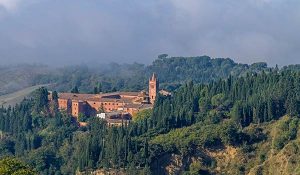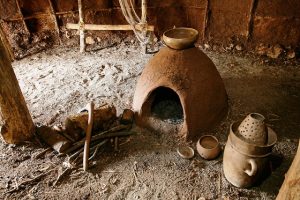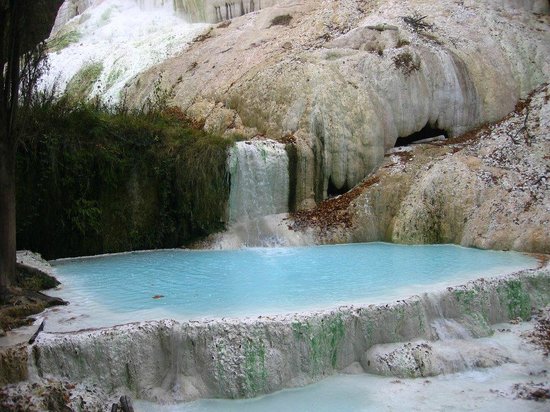When people think about Montepulciano, the first thing that comes in mind is a glass of red wine. The second image is a sunset over endless vineyards. But Montepulciano is not only that. If you want to escape rowdy tourists and enjoy a calm day off the beaten path follow our tips, discover a less beaten track and walk, cycle or drive to these hidden treasures around Montepulciano.
 The Fosso Bianco, Bagni di San Filippo.
The Fosso Bianco, Bagni di San Filippo.
Bagni di San Filippo is a small village on the slopes of Mount Amiata and on the edge of Val d’Orcia (Southern Tuscany, Unesco World Heitage) known for its thermal water. For nature lovers the Fosso Bianco is the perfect place, a stream in the woods with several hot springs which form a series of pools where you can swim all year long. The shape of the limestone formations have inspired the evocative name ‘the white whale’. Have a look at the picture and guess why…
If you prefer art to natural landscapes, or even better better art and natural landscapes, one of the places you should definitely not miss is the Abbey of Monte Oliveto Maggiore.When exploring the area you can reach the Abbey through Trequanda and Asciano. This itinerary allows you to enjoy the countryside at the heart of the Crete Senesi area. The Abbey is situated in a beautiful position among the eroded soil of “Calanchi” and forests of cypresses and oaks. When there, don’t miss the nearby hilltop village of Chiusure, where you can stop for un aperitivo (pane, prosciutto, pecorino e un bicchiere di vino rosso of course) and climb the panoramic terrace.
 The Abbey was founded in 1313 by Sienese Bernardo Tolomei who retired in this place, property of his family, after he converted to Benedictine order. Some years later he began the construction of the Abbey. The structure as you see it today has been completed during the following centuries. In the Great Cloister, the history of the Order is shown in the works of many famous artists (Signorelli and Sodoma among them).
The Abbey was founded in 1313 by Sienese Bernardo Tolomei who retired in this place, property of his family, after he converted to Benedictine order. Some years later he began the construction of the Abbey. The structure as you see it today has been completed during the following centuries. In the Great Cloister, the history of the Order is shown in the works of many famous artists (Signorelli and Sodoma among them).
 Whereas the Middle Ages and the Renaissance times are testified here by so many works of art, the Civic Museum of the Prehistory of Mount Cetona documents the various phases of human settlement in the area around Mount Cetona from the Paleolithic to the Bronze Age. The prehistorical human presence in this area begins in the mid-Paleolithic period: Neanderthal man lived in caves on Mount Cetona, leaving as traces of his passage tools made from sharpened stone and remains of animals hunted.
Whereas the Middle Ages and the Renaissance times are testified here by so many works of art, the Civic Museum of the Prehistory of Mount Cetona documents the various phases of human settlement in the area around Mount Cetona from the Paleolithic to the Bronze Age. The prehistorical human presence in this area begins in the mid-Paleolithic period: Neanderthal man lived in caves on Mount Cetona, leaving as traces of his passage tools made from sharpened stone and remains of animals hunted.
At the Belverde Archeological Park some of the caverns that open up in the travertine rock can be visited.
by Il Sasso, Italian school staff in Montepulciano


